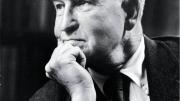“The spontaneous propulsion of [my] thoughts by the sanguine surplus…”—so Henry A. Murray ’15 described his intellectual process in “The Case of Murr,” an autobiographical chapter published in 1967. “Sanguine surplus,” or raw exuberance for knowledge, became his creed. (This vitality extended beyond academic enterprises; although married, he had a lengthy affair with his closest collaborator, Christiana Morgan.) He became one of psychology’s original voices, but is sometimes overlooked today: in part, perhaps, because his personality led him into unnecessary battles with fellow psychologists over what could be considered valid research, and because he enthusiastically began projects that he obviously cared about, yet never completed.
Murray sought the origins of life, a quest that led him to study history at Harvard and earn an M.D. and a master’s at Columbia and a Ph.D. in biochemistry from Cambridge. (By his own admission, this varsity crew captain became a dedicated student only in medical school; his relatively easy educational progress may have seeded his frustration with some of his later endeavors.) Embryology brought him closer to life’s beginnings, but a larger mystery loomed. He found his calling at 30, when he read Carl Jung’s Psychological Types. After private sessions with Jung in 1925, he eventually left biomedical research to pursue psychology, a field he approached as “deep diving.” Physiologist Lawrence J. Henderson, his mentor, encouraged the head of the Harvard Psychological Clinic (HPC) to hire Murray as his assistant; he started there in 1927. After private sessions with Jung, he left biomedical research to pursue psychology.
At the HPC during the 1930s, Murray and lay researcher Christiana Morgan developed the Thematic Apperception Test (TAT), a set of picture cards, still used, that challenge subjects to invent a story, a process that often reveals more about their psychological states than responses to direct questions do.In an era when many other academics disdained psychology as “unscientific” and impossible to research, Murray disagreed, having worked out protocols for interpreting nontraditional data. He applied empirical methods—standardized data collection and interpretation—and pioneered the longitudinal study, in which investigators follow their subjects to determine whether initial results are stable or changing.
But he was also developing his own branch of psychology. Having studied Jung, he incorporated biology, sociology, culture, and literature into his research. (He promoted the works of Herman Melville—believing the Pequod’s crew illustrated every psychological type—when the novelist was largely ignored by the academy.) He dubbed his approach “personology”; its tenets include studying individual life histories to find the main themes, internal drives, and outside factors that influence personality formation.
When some in the field suggested this work lacked rigor, Murray—who rose to any challenge, including his own crossed eyes and a stammer—began to speak about the pointlessness of academic psychologists attempting to apply the principles of science to something as complicated as the mind. They “are looking critically at the wrong things,” he wrote in 1935, while psychoanalysts (who had accessed the origins of personality, but lacked the scientist’s discipline and the opportunity to share and refine what they learned) “are looking with reeling brains at the right things.”
Appreciation came with Explorations in Personality (1938), a journey into the mental worlds of 50 young men who volunteered as subjects. He shared authorship with the HPC staff, though a student, Robert R. Holt, Ph.D. ’44, has said Murray did most of the writing. The book electrified many psychologists and their students, showing there could be far more depth to their research than the quantitative data on reflexes or perceptions most experimental psychologists reported. Murray found such studies unspeakably dull.
He guided research at the HPC with a view that psychology, informed by psychoanalysis, could address human problems; during World War II, he devised testing to help the Office of Strategic Services choose intelligence officers scientifically. In 1946, President James B. Conant offered him a full professorship in the new interdisciplinary department of social relations, a grouping of social, developmental, and personality psychology with sociology and social anthropology. Soc Rel fit beautifully with Murray’s goals—outside the psychology department, he would be free to pursue personology. But he rejected the offer, to focus on research and writing. He guided research with a view that psychology, informed by psychoanalysis, could address human problems.
Nevertheless, he became professor of clinical psychology in 1951 and contributed to Soc Rel’s development until retiring in 1962. His willingness to teach women and support their research when many of his colleagues refused was honored in 1976 when Radcliffe College opened the Murray Research Center, dedicated to longitudinal research, particularly on women. (Its archives are now housed at Harvard’s Institute for Quantitative Social Science.) Meanwhile, writing projects attracted and bedeviled him: a multivolume study of Melville, a book on hubris, and a memoir, coauthored with Morgan, about their love affair. Yet by 1967, he had acknowledged “the fading of the mental energies” on which he had been counting to deal with some of his half-finished books, “residual products of [my] sanguine surplus.” Those who carry on his work today follow the charge he used on a medal that he and Morgan designed to honor the HPC in 1937: “Let Not Him Who Seeks Cease Until He Finds, And When He Finds He Shall Be Astonished.”









